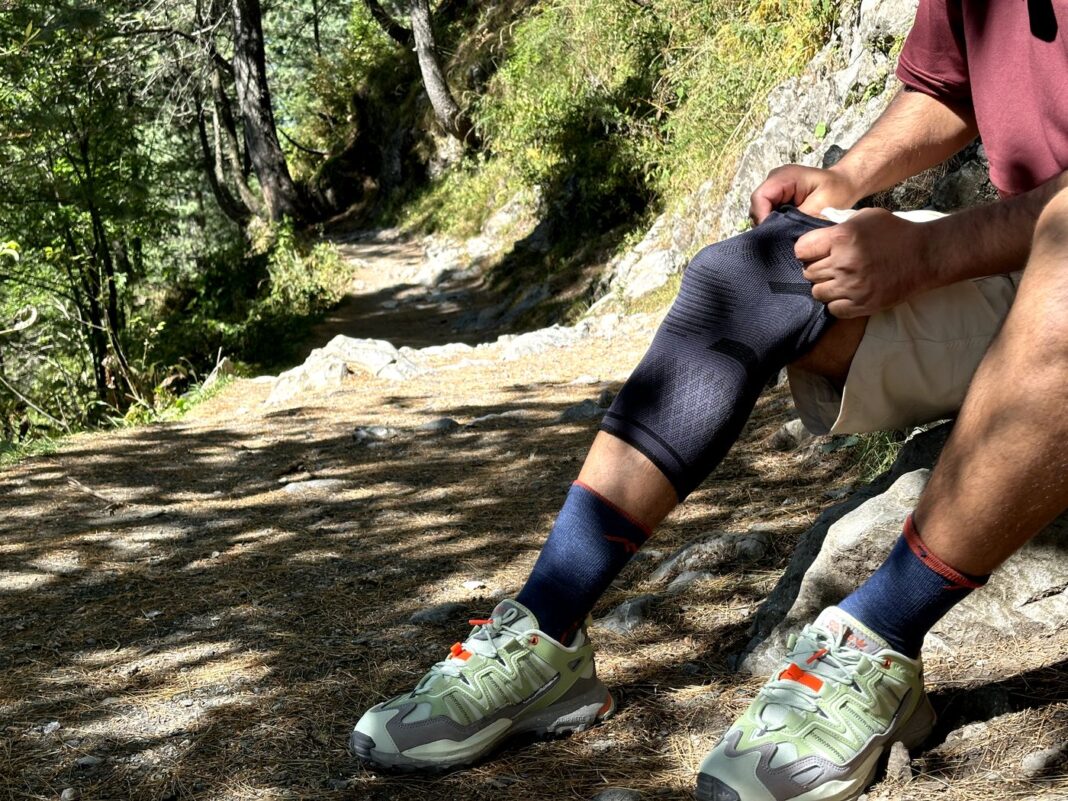The majority of hikers neglect to choose proper hiking socks and end up suffering on the trail despite wearing comfortable hiking shoes. Socks are just as important as your shoes. Choosing any pair of socks for hiking won’t suffice, especially if you’re planning a hike or backpacking trip that lasts for several hours.
Hiking socks are often made of wool with a blend of materials such as polyester, nylon or polypropylene.
In addition to that, the majority of the sock industry is making use of Merino wool which creates a static-free, itch-free, antimicrobial and moisture-controlled environment for your feet. A quality hiking sock keeps your feet dry and prevents blisters. It also provides warmth and support.
However, with the overwhelming number of sock options available on the market, selecting the right pair can be a difficult task. This guide will help you choose the ideal pair of hiking socks.
Key Takeaways
- Hiking socks are specially designed to protect your feet on the trail by providing comfort, cushioning, quick drying, and moisture-wicking features.
- There are different types of socks, such as athletic socks (hiking and running socks), compression socks, general use socks (mainly cotton), and specialty socks.
- Some key factors, such as sock height, weight, cushioning, material, moisture-wicking, comfort, and durability, need to be considered when buying hiking socks.
- Proper care and maintenance of hiking socks are a must to ensure their longevity.
- You will also learn about common questions that hikers ask about socks, such as thick or thin socks, hiking with two pairs of socks, the importance of wool socks, and the proper length of hiking socks.
Types of Socks
Socks come in various fabrics and are designed for different tasks. We have listed all types of socks so you can figure out the best option for you.
Athletic Socks
- Running Socks
These socks provide the relief and comfort you need while running to boost your performance. Running socks consist of materials like a blend of wool, synthetic, and cotton. These socks come in a variety of patterns and fabric weights.
You will get long-term moisture and protection from these socks which help to lower the chances of blisters and foot strain. There is an obvious difference between regular and running socks.
- Hiking Socks
These socks are made of wool and synthetic materials and come in different sizes. You can wear most of these socks only with hiking shoes, although others are compatible with both hiking boots and shoes.
These socks come in two weights: heavy and lightweight. The material and thickness of hiking socks are different from those you use for jogging. Hiking socks are essential if you want to run long distances on trails, go on day hikes or backpack.
Compression Socks
Compression socks are popular among sports and hiking enthusiasts. These socks are made from a blend of flexible and breathable fabrics and are available in various pressure levels to meet many needs, ranging from light support for everyday wear to higher compression for medical purposes.
Compression socks help reduce pain, improve blood flow, and provide warmth and protection on the trail.
Athletes and tourists wear socks because they might boost power and speed up recovery. These socks are a bit expensive for some people but are a one-time investment and are worth buying for daily wear and other physical activities.
General Use Socks
General socks are available in various colours, patterns, and sizes. Generally, they are made up of cotton, wool blend or polyester material and are best for daily use.
But these are suitable for summer only and are not perfect for winter or the rainy season. These socks are not as durable as athletic socks.
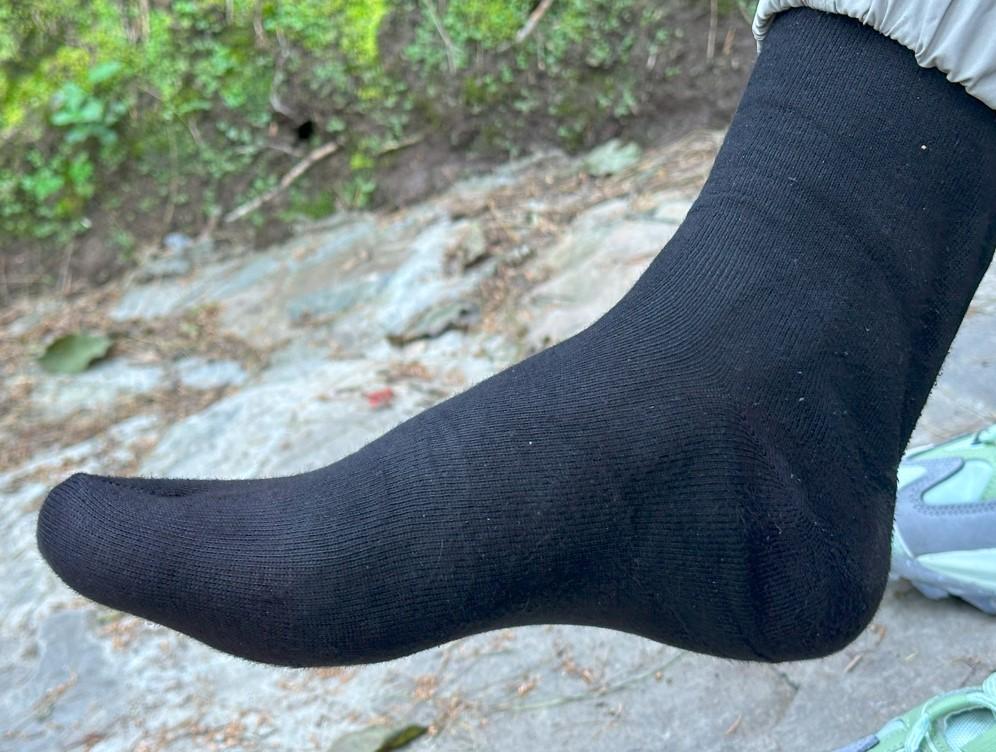
You will find these general socks in every grocery and department store and in everybody’s wardrobe. These socks provide essential protection that helps to avoid blisters due to the friction within the shoes and control moisture levels.
Related: Why Cotton is Bad for Hiking
But these socks are not suitable for hiking due to a lack of proper moisture management mechanisms, cushioning, odor resistance, durability, and warmth. .
Specialty Socks
These socks are designed for medical necessities. Regular socks are made for daily use, whereas specialist socks are made for sports like skiing, hiking, and running. It is made of materials such as wool and fleece, which help to reduce swelling.
Specialty socks offer superior cushioning and breathability to improve performance and reduce fatigue.
These socks are made specifically for diabetic patients and offer health advantages like increased blood flow and reduce puffiness.
Specialty socks are anti-slip, so you can do barefoot-like activities. You can also call them thermal socks because these keep your feet warm and are best for winter.
What are Hiking Socks
These socks are designed for long runs and hiking. Hiking socks are made in a way that helps to reduce resistance between shoes and feet. These are some of the best choices if you are looking for an option that provides warmth and helps to protect your heels and toes.
Not only do they provide the comfort, but they are manufactured with constituents that are sturdy, provide stability, and work with your boots to give your feet a breathable, moisture-controlled movement.
Mostly made of wool, hiking socks are made to provide insulation against the weather conditions.
Instead of absorbing the moisture, they wick away the moisture from your feet in order to provide a no-slip surface to your foot. Hiking socks are made to cushion your feet against shoe abrasions.
Wool and synthetic are the two most common materials for hiking socks, and both have many of the same qualities as wool. They come in a range of hues, dimensions, and designs. In many cases, hiking socks are far more durable than their stylish counterparts, especially when you compare them with ordinary socks.
How to Choose Hiking Socks
Hiking Socks Height
Hiking Socks provide comfort, security, and practicality on the trail. They are available in various types, including no-show, ankle, crew, and knee-high styles. Each style has its benefits and is suitable for a specific condition. You can choose among these socks according to your needs.
- No-Show Socks: No-show Socks are best for low-cut footwear. These socks provide minimal protection to your feet to prevent friction with shoes. You can use these socks with shoes for running on trails or with light hiking shoes.
- Ankle or Quarter Socks: You can wear these socks with mid-cut boots or shoes. The ankle or quarter socks length is slightly higher than no-show socks, which helps to provide a bit more protection. These socks cover your ankles completely. Thus, these socks help to avoid abrasion.
- Crew Socks: These socks are ideal for hiking and are 6 to 8 inches high from heels. Wear these socks with both high-cuff and low-cuff boots. Crew Socks are a few inches high from the ankle and provide complete protection from friction. You can also use them for casual use in winter.
- Knee- High Socks: These socks do not have many options and are not widely used. It helps to protect your shin and calves from getting bruises from long boots. You can use these socks in winter to keep your legs warm in winters.
No-show Socks do not cover the ankle. You can wear them with low-cut shoes. But no-show socks are not ideal for short-distance hiking or urban settings as they do not have ankle protection and expose your skin to dirt and debris on the trail.
Ankle and low-cut socks are the best choices for light hiking or hiking during the day in winter. Ankle socks are more prone to insect bites or wounds.
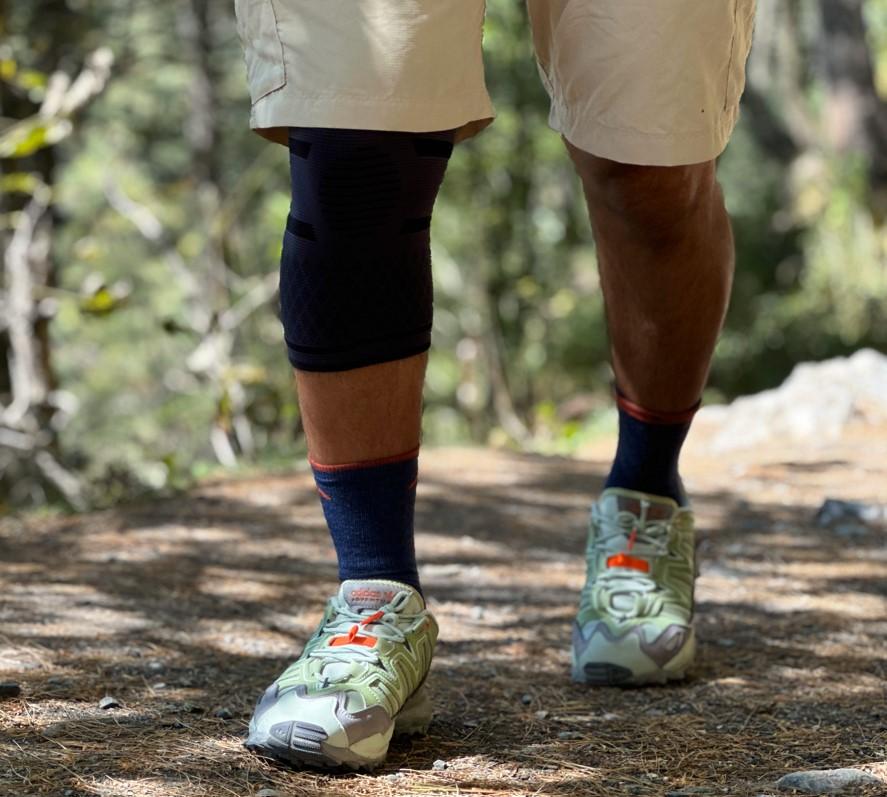
Crew socks are among the most common choices among hikers. They can protect your feet from dirt, debris, and rough areas. Because they are long, they completely cover the ankles. We prefer these socks for hiking.
Knee-high socks are best for the winter season, and wet areas aid in safeguarding your legs from snow, water, and insects and offer warmth.
Hiking Socks Weight and Cushioning
Ultralight No Cushioning Socks
You can wear these socks in both hot and cozy weather. But these are designed for summers due to slight padding. Perfect for day hiking, technical alpine climbs, hot summer weather, or short trails. No Cushioning socks include a few liner socks.
There are varieties of hiking socks available in the market; I always prefer socks with proper cushioning instead of liner socks.
Lightweight Light Cushioning Socks
Light cushioning socks are thin as compared to medium and heavy cushioning socks but provide comfort to both metatarsal and heels. The best weather conditions for these socks are warm to cool.
You can use them for day hiking, backpacking, biking, running, and other outdoor activities. But these socks are not suitable for winter or chilly weather, especially if you wear shoes with mesh panels.
Medium Weight and Cushioning Socks
Medium-weight socks are crafted from materials such as synthetic blends and Merino wool. These socks provide a lot of padding in the heel and ball of the foot, which keeps your feet blister-free.
These socks offer a good mix of sustainability, warmth, and comfort. Medium-weight socks are heavier than lightweight socks but remain breathable. It makes them ideal for warm to cold weather. You can use these socks for short and long hikes, backpacking and other outdoor activities.
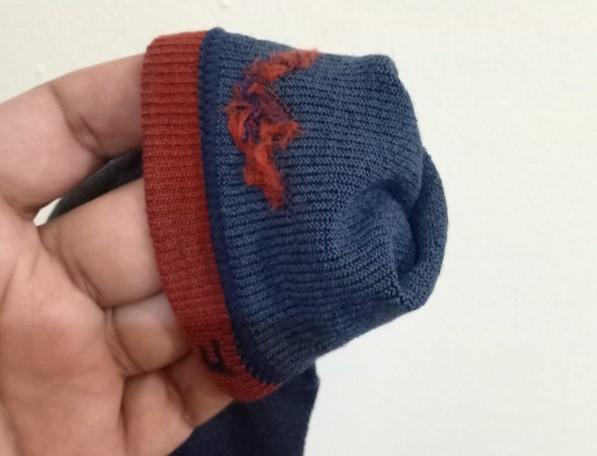
Medium-weight socks provide extra insulation. For those looking for a versatile option, these are among the best choices and crucial for a pleasant experience.
Heavy Weight and High Cushioning Socks
Heavyweight socks are made of materials like merino wool and synthetic blends. These socks are designed for cold weather and are thicker and more highly cushioned in all types of cushioned socks.
Usually, these socks are designed for long hikes, rough terrain, and severely cold temperatures. We strongly suggest wearing heavy-weight socks when hiking throughout the winter.
Hiking Socks Fabric
The most important thing keep in mind when you’ve undertaken trekking across the mountains is the comfort level, this is why most people hesitate to hike because they don’t have adequate knowledge and access to the proper trekking gear.
Comfortable hiking boots and a good pair of socks plays a huge role in making your hike memorable and stress-free should you come across natural calamities.
The very first thing to consider is the best material for hiking socks. There are many types of fabric material socks which commonly include synthetic fibers, Merino wool, polyester and cotton socks etc.
Merino wool socks are by far the best go to when it comes to the fabric quality. But before choosing what socks to buy, it is crucial to know what they will be used for, either hiking or for a casual wear. It is also important to keep in mind the weather conditions in which they will be used.
Comfort Level
People are leaning more and more towards the Merino wool socks because of how durable and comfortable they are. The material of these socks comes from the sheep wool that lives in the severe mountain weather and is native to the New Zealand’s Southern Alps.
Toe socks are specifically made to minimize the discomfort on the hiking trail so that your toes doesn’t press together which might cause soreness and calluses to happen.
You have to pick and choose a perfect pair of socks which offers great arch support and in turn cause you less foot fatigue and blisters from a long hike. The sock brands that have extra cushioning and heel padding might be the perfect fit in these situations.
Brands like Darn Tough and Smartwool strives to provide the hikers maximum comfort but there are some minor downsides to each one of them. Darn Tough Hiker Micro Crew and Darn Tough Light Hiker Micro Crew Socks are my personal favorites, and I always get exceptional comfort and support on the trail from these socks.
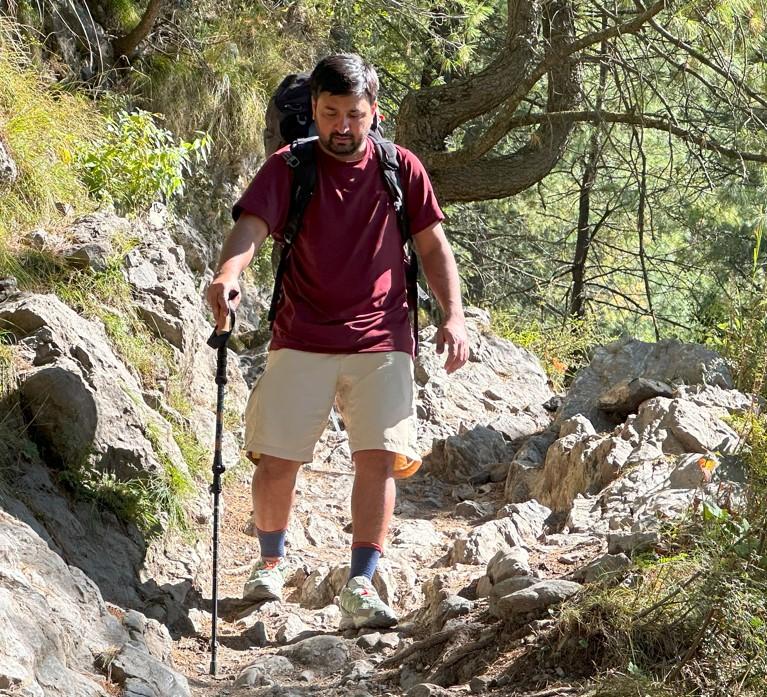
Darn Tough socks can be thicker and heavier on the feet but are very durable in every situation whereas Smartwool though provide excellent fit lacks in durability. It really depends on every individual’s comfort level because everyone has a different preference when it comes to buying the best branded socks.
Breathability And Moisture- Wicking
When you are looking for hiking socks, always consider the maximum fabric breathability. It helps in making your foot comfortable and dry in hot weather so you don’t sweat much when you’re moving fast.
The breathability panels allow the foot to remain cool in hot conditions. It takes the sweat away from the arch of your foot so your feet would not get cold when you are just walking; it is extremely helpful in cold weather.
Depending on the weather conditions, Merino wool sock has an advantage in that area since they are very comfortable and absorbs moisture well if they get wet.
Durability
Socks tend to lose their durability after being washed several times, no matter the brand. But they can also last for a long time if they are being taken care of properly. Most wool socks including Merino provides more resilience and lasts longer than any cotton, silk or polyester socks.
Some brands offer the life time guarantee on their socks, which means even if you’ve holes in your socks, you can still send them and claim a new pair but you have to invest in buying that guarantee from the specific brand.
Specific material socks like Merino wool require special care when washing; make sure to always check the washing instructions for your socks to last longer and for better durability.
Choosing the Right Fit
Choosing the perfect size according to your feet is extremely crucial when hiking. If you wear the socks that are too long or lose on you, it can cause them to bundle up in your shoe and making it very uncomfortable to walk which in turn will cause calluses and blisters.
If the socks are too tight, it will put a lot of extra pressure on your foot making it painful to walk. To avoid all that, it is important to know your actual foot and show size.
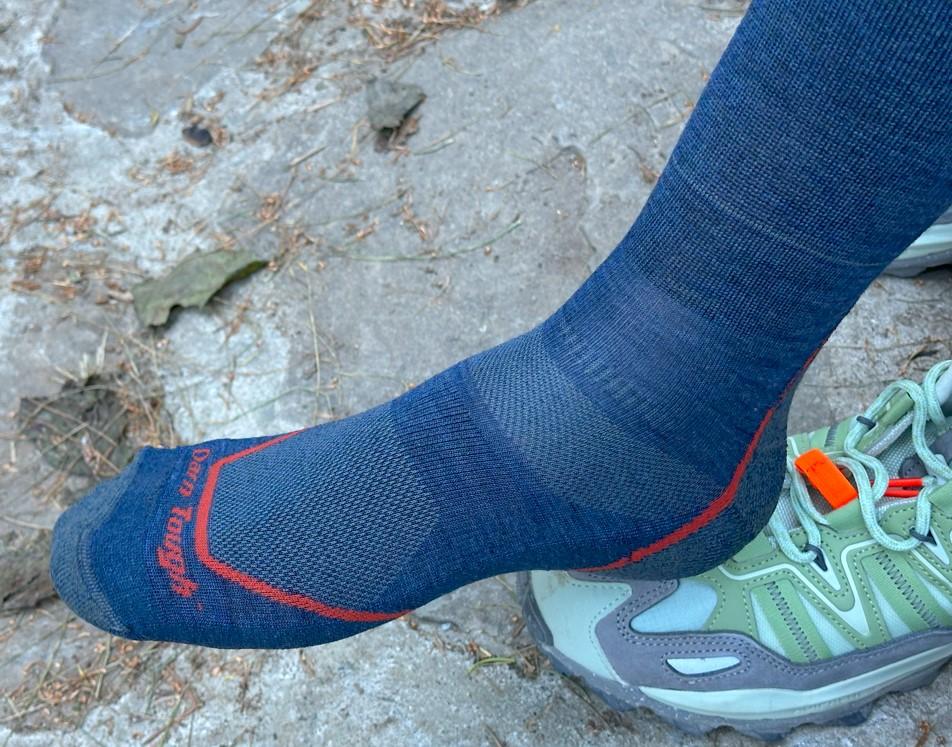
Size charts help you to determine which socks would be best fitted for you based off of your show size. Always try on the socks once you buy them before going on the hike. You don’t want to just go with it knowing you don’t have another option once you are on the trail.
Choose the right pair of socks that are not too big or tight on your feet. You will know it’s what you’re looking for when the heel lining of the socks perfectly lines up with your heel.
Care and Maintenance of Hiking Socks
Some times when you follow the advertisement instructions of how you should wash your socks, instead of lasting it longer, it ends up shortening its lifespan.
For Merino wool socks it is generally recommended to be washed with cold water and line drying afterwards. Since Polyester socks are made with recycled materials and synthetic fibers, it is easier for them to dry.
It is best to lay your socks inside out and flat on a surface rather than stuffing them in your shoes especially when you have to use them again while hiking. It helps to prevent them from stinking especially in the humid weather conditions.
You should avoid putting your socks in a dryer because they tend to shrink and lose their durability for future use.
FAQs
What Socks Should You Wear While Hiking?
Always compare and contrast before buying a pair of hiking socks but we strongly recommend getting merino wool socks. They provide a very nice feel to your feet after a long hike in rain and snow. The synthetic build-in fibers helps prevent your feet to get sweaty and itchy.
The fibers absorb away the moisture and prevent your socks from getting that musty stink. If you are looking for a pair of socks with the maximum comfort and warmth, go for the one that is mainly made with merino wool.What is The Difference Between The Hiking Socks And Regular Socks?
Hiking socks are specifically made for hiking and trekking purposes because of their in-build moisture wicking material. It is mostly preferred that hiking socks should be of the best quality wool material while regular socks can just be of cotton.
Regular socks are usually made of cotton and accessorize your everyday footwear. The cotton seldom helps in protection, stability or cushioning.
If you were to wear your hiking boots with regular socks, your feet will be more susceptible to blistering, sweaty and should they get wet, the absorption would cause you to halt entirely for a change of pair.
On the contrary, hiking socks compliment the resilience of your hiking boots. The next-to-skin knitting pattern of the yarn fits snuggly around your feet, resisting shoe-abrasion and usually a single pair can last longer than your regular cotton socks.Should Hiking Socks be Thick or Thin?
It depends on the weather conditions under which you will be wearing your socks. Thick hiking socks can be of a heavyweight because of the extra padding in the heel area to provide warmth and comfort in the cold snowy weather.
Depending on the climatic conditions of your trail, you can choose between a pure wool sock or a wool and synthetic material blend.
If your range is rugged and has cold, harsh climatic weather; you need a pure wool sock that is thick and weathers the storm with you. Pure wool provides heavy cushioning and retains heat to save you from cold.
For the pleasant cool summer weather it is often recommended to wear socks that are neither too thick nor too thin. For the day time hikes in summer, you should wear the socks that have extra breathability and the panels on the arch to absorb sweat. Hence it depends on how much distance you will be going on.Why do Hikers Wear Two Pairs of Socks?
Sometimes hikers wear two pair of socks to provide maximum comfort and prevent blisters. It also helps reduce roughness between your foot and socks and in turn give extra warmth in cold weather. It’s always recommended to wear liner socks instead of two pairs on each other to avoid them bundling up.
Which is Better, Merino or Synthetic Hiking Sock?
Though synthetic fiber socks are more durable than merino and dries quicker but it lacks the warmth, especially if you are planning to hike in colder weather.
Synthetic socks are well suited for warmer weather. It depends on the hiker and on the conditions in which the hike is taking place. One should plan accordingly.
Hiking socks make a great difference to the quality of your hiking experience. Once your feet are cushioned, they are less tired making you stick to a schedule. Your feet aren’t sweat slicked, the antimicrobial qualities of wool also promise a decreased risk of bacterial overgrowth.Are Hiking Socks Worth It?
Though hiking socks have gotten pretty expensive over the years but investing your money in getting a good pair of hiking socks is always worth it especially if you are planning for long hikes. Besides, they last longer and some branded companies like Darn Tough have lifelong warranties and it always makes the investment worth it.
Cushioning your steps is as important for a rugged terrain as it is for an easy-to moderate trekking trail. Your feet and ankles take the brunt of the shock your walking, and your footwear helps in regulating shock absorption.
Hiking socks have an added feature of cushioning your jog, they are snug around the heel and the ball of your foot, providing you comfort during extreme-exertion.
Together with the hiking boots, hiking socks provide lucrative biomechanics for mountaineering and traversing through rough terrain.Can You Wear Normal Socks With Hiking Boots?
Regular socks may provide you comfort during a short-distance running trail, they are inappropriate for a hike. Most regular socks are made of cotton which provides no cushioning, zero stability and doesn’t provide temperature regulation.
When cotton gets wet, its fibres lose their shape, mat together and lose their quality to ventilate. They have a long drying out period which makes them a burden to carry.
During a hike, the breathability of a sock guarantees wicking and water-proofing. Cotton lacks that quality and makes it impossible to allow water evaporation.Should You Wear Cotton Socks for Hiking?
Cotton socks can provide you with style but not with support. For an outdoor exercise which demands rigorous performance, cotton is a poor choice.
Cotton has no insulating properties which means it can not retain body heat. The precious energy needed for hiking will be wasted in keeping your feet warm.
Cotton takes a lot of time to dry, thus if your cotton sock has gotten wet on a cold hike, you might be running a risk of gangrene or frostbite.
In hot climatic hikes, the sweat mats the fibre of the cotton and since the breathability is reduced, your feet will be swimming in a pool of sweat.
Once cotton gets wet, it loses its shape, the microfibers mat almost immediately resulting in poor ventilation.
Not only will you have a very wet pair of cotton socks on your hands, but the drying out time will make you lag behind significantly.What Kind of Socks to Wear Hiking in Summer?
Summer hiking requires a sock that has high breathability, maximum ventilation and a quick drying out time. The best option for such a hike is a blend of wool and some synthetic fibre such as nylon or polyester.
The synthetic yarn of these socks provides durability, more breathability than a pure woollen sock and absorbs less water content if it gets wet.
The drying out time of such socks are incredibly low and wicking is great, they still provide more cushion than a regular sock.What Length Sock is Best for Hiking?
The most appropriate length for a hike is a ‘crew’. These socks cover a few inches above your ankle, providing optimum cushioning, maximum protection against shoe-cuff scraping and enough warmth on cold weather condition.
The ‘knee-high’ length is best for mountaineering and rugged terrain. This is the least varied category which requires an alpine trek for you to enjoy its features.
If you are hiking in the long hiking boots, it is recommended to wear the tall length socks which will provide leg protection against the accidents or sudden injuries you might get on your hike and will keep you warm in colder environment.
The tall socks are also helpful and go easily with hiking boots. While the shorter socks are best suited for hiking shoes rather than boots preferably in warmer weather to help provide more breathability which in turn will keep your legs cooler.
Sock height is necessary to prevent shoe abrasion, shoe-cuff scraping and toe to heel fit of the sock. If you are wearing a low-cut boot, a ‘No-show’ or ‘Ankle’ sock will match your style and comfort.
While no-show sock lengths are great with hiking sandals and moccasins, they can only be used for light hiking.
